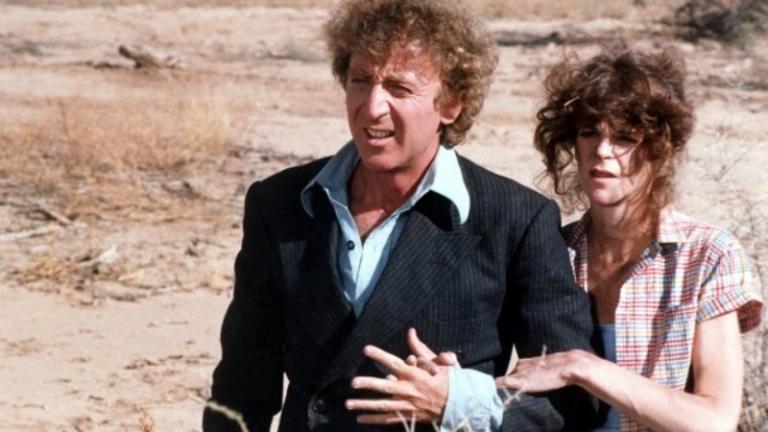The latest in a month-long series of re-posts from my Facebook marathon in April 2020.
–
Sidney Poitier marathon part 18b (1982-1985):
Sidney Poitier’s second film with Gene Wilder saw him playing inadvertent matchmaker for his leading man.
Hanky Panky (1982) was the first Poitier-directed film that did not feature a black lead actor, though at one point it almost had one. Apparently the film was originally developed as yet another vehicle for Wilder and Richard Pryor, following their huge success with the Poitier-directed Stir Crazy two years earlier, but for whatever reason, Pryor dropped out and his part was re-written for Gilda Radner — who famously fell in love with Wilder on the set of this film and married him two years later.
The plot hinges, once again, on Wilder being falsely accused of murder and finding himself on the run from both the authorities and the bad guys. Wilder spends a lot of time reacting to the absurdity of his situation by shouting hysterically, which I think is supposed to be funny but increasingly comes across as merely annoying.
It doesn’t help that, to get away from the bad guys at one point — while they are on an escalator in a public place — Wilder sexually assaults the woman standing in front of him (i.e. he grabs her between her butt cheeks, in a tight close-up) and tricks her into thinking it was one of the bad guys who grabbed her, which prompts her boyfriend to pick a fight with the bad guys. Presumably someone thought this was a clever gag at some point, but now it just hinders any sympathy we might have for the Wilder character.
The only scene I found genuinely funny is when Wilder and Radner are in a small plane, and the pilot begins belching… and belching… and belching… and the scene drags on so long that Wilder and Radner can’t help laughing, or trying to suppress their laughter, and you’re not quite sure if you’re watching the actors or the characters react to how absurdly long this goes.
And then the pilot dies, and Wilder starts shouting hysterically again because he doesn’t know how to fly the plane, and he refuses to admit that the pilot has died because that would stress him out even more, and it’s all very annoying again. Sigh.
A few other quick points:
— Wilder’s character is named Michael Jordan. This film came out two years before the basketball star of that name began playing for the Chicago Bulls.
— A key plot element is that the bad guys can brainwash people into committing suicide. This is vaguely reminiscent of the (much more benign!) hypnosis plot device in 1975’s Let’s Do It Again.
— In one scene, a kid plays with one of those toy cars that makes sparks when you let them go on the floor. Do people still make those? (In the film, the car gets too close to a kitchen where one of the brainwashed people has turned the gas on and stuck his head in the oven, and the sparks make the room blow up.)
— It turns out the MacGuffin driving the plot is a computer tape. A tape!
— As always when watching 1980s movies that I have never seen before, it’s fun to see character actors who I recognize from other films of that era, as well as now-familiar actors who were just beginning their careers back then. In the former category, the film has Josef Sommers (the corrupt police chief in 1985’s Witness), James Tolkan (the principal in 1985’s Back to the Future) and Victor Argo (the apostle Peter in 1988’s The Last Temptation of Christ). And in the latter category, William Sadler (the bad guy from 1990’s Die Hard 2) appears as a hotel clerk, and Jay O. Sanders (who also played Peter, in 1980’s The Day Christ Died!) is one of the bad guys.
— Reunions: In addition to Wilder, this film also reunites Poitier with Richard Widmark, who co-starred with him in three films between 1950’s No Way Out and 1965’s The Bedford Incident.
— Hanky Panky grossed only $9.8 million and ranked 69th for the year.
The last film Poitier directed during his decade-plus hiatus from acting was Fast Forward (1985), a musical about teenaged dancers who go to New York in hopes of winning a major talent competition.
The film is something of an outlier in Poitier’s filmography. It is the only directorial effort of his that features no actors from his earlier films (as far as I can tell), and the MTV-ready dance sequences are a far cry from Poitier’s only other musical, 1959’s Porgy and Bess (which was based on a 1935 opera).
Why did Poitier make this film? I have no idea, though I do note that his daughter Pamela, who turned 31 the year the film came out, is listed in the credits as a “dance assistant”, and I wonder if he made the film partly because someone in his family wanted to make a dance movie.
In any case, it’s not too hard to see why the studio made this movie. Some people have compared this film to 1980’s Fame and the TV series that followed it, which I have never seen, but I can believe that this film was aimed at a similar demographic. Also, the breakdance sequences in this film remind me that it came out one year after 1984’s Breakin’ and its sequel, which I have also never seen. Stuff like this was in the air at that time.
Alas, the script plays on many of the cliches that one would expect from this genre without rising above them, and the acting is TV-sitcom level at best. (I am not at all surprised that I have never noticed any of these actors in anything else over the past 35 years.)
And when the plot reaches its climax, it has something to do with an elderly woman taking the dancers under her wing — spiking and dying her hair along the way — because she is tired of being “old and retired”. It is not hard to imagine that Poitier, who turned 58 the year this film came out, identified with this character on some level and was trying to prove that he, too, was still one of the cool kids.
A few other quick points:
— The music is very, very mid-1980s. It totally brought back memories of that era, even though I had never heard any of these particular songs before.
— At one point the dancers sneak into a swanky restaurant and interrupt the gentle piano-playing there by hiding a ghetto blaster under a table and playing a beat-heavy track while they dance and sing within the restaurant itself. Naturally, the movie’s sound mix brings the voice and instruments together with perfect clarity, as though this were a music video. But I kept wondering what it would really sound like if the instruments were coming from a tiny machine hidden under a tablecloth over there while the singing was coming from one guy over here and there was also the extra noise made by all the dance steps taking place in-between those two spots. (And how forcefully could a guy sing while doing all those highly aerobic dance moves, anyway?)
— One subplot involves the women on the dance team learning how to defend themselves against the would-be rapists who harass them in stairwells and beat them in back alleys.
— Another subplot involves the dance team’s leader having a fling with some rich girl who makes eyes at him during one of the team’s public street-dance sessions. Naturally, the team leader’s girlfriend is jealous — and she is outraged when she learns that he spent $86 on his lunch with the rich girl. (What would that come to nowadays, after 35 years of inflation?)
— The one actor I recognize is Robert DoQui, who went on to play the sergeant in all three RoboCop films between 1987 and 1993. Here he plays the father of one of the dancers. Also, Boy George has a blink-and-you’ll-miss-it cameo as one of the dancers at a nightclub called The Zoo.
— Reunions: Aside from Poitier’s daughter, who had a bit part in 1980’s Stir Crazy, the only name I recognized in the credits from Poitier’s earlier films was “executive music producer” Quincy Jones, who scored six of Poitier’s films between 1965’s The Slender Thread and 1971’s Brother John (and who, at this point, had just produced Michael Jackson’s hit 1982 album Thriller). Jones did not actually compose the music for this film, though; he was too busy producing Spielberg’s The Color Purple (not just the soundtrack, but the entire film).
— Fast Forward grossed only $2.8 million and ranked 131st for the year. I’m not sure I had even heard of the film until I saw it in Poitier’s filmography while doing this marathon.
–
Bonus content: Just to provide a bit of extra historical context, here is a Facebook post I wrote after watching films by two younger black directors who were making a name for themselves on the independent scene while Poitier was directing films for the mainstream studios:
–
Yesterday’s 1980s catch-up: She’s Gotta Have It (1986), now streaming on Netflix, and Hollywood Shuffle (1987), now streaming on the Criterion Channel.
After watching all of the films Sidney Poitier directed between 1972 and 1990 — and particularly after watching how, um, mediocre they got over the 1980s, as Poitier shot past his 60th birthday — I figured I should check out what younger black filmmakers like Spike Lee and Robert Townsend were doing at the time. (Lee and Townsend both turned 30 in 1987.)
And, well, yeah, these films definitely aren’t as polished on a technical level as the more mainstream films that Poitier was making at that time, but there’s an energy and a relevance to them that is still evident now, over 30 years after they first came out, that the Poitier films of that era don’t have, and probably never had.
I remember seeing Siskel & Ebert review these films when they first came out — I particularly remember how Siskel & Ebert commented on the fact that there is a parody of their show in Hollywood Shuffle — but I had never gotten around to watching these films until now.
She’s Gotta Have It feels a bit like a student film, but in good ways more often than not. I had seen clips from the film over the years and knew it was shot in grainy black-and-white, but I had not realized that there is one dance sequence that is shot in gloriously bright colour.
I’m also curious to know what sort of discussion there has been around the film’s depiction of its female lead character’s sexuality; on the one hand, she seems like an empowered character, but on the other hand, she exists within a film that was written and directed by a man (who cast himself as one of her boyfriends, though at least he did not give himself the same kind of sex scenes with her that her other boyfriends get). And I suspect the hint of lesbianism, which might have seemed edgy at the time, would be considered too tame today. (Yes, I am aware that there is a Netflix series based on this movie now, and that the series might reflect some of the cultural shifts of the past 30+ years, but I have not watched it.)
As for Hollywood Shuffle, it’s an amusing parody of Hollywood genres and racial stereotypes, but it also has some moments that struck surprisingly deeper than I expected, as the main character — an aspiring actor — wrestles with whether to pursue his dreams in the face of Hollywood ghettoization on the one hand and skepticism from family and friends on the other hand who think that being an actor isn’t just a pipe dream in general (“why don’t you get a real job,” and all that) but a form of Uncle Tom-ism for black actors specifically.
Side note: Hollywood Shuffle was co-written by Keenen Ivory Wayans, whose third film as director, Scary Movie (2000), would go on to pass Poitier’s Stir Crazy (1980) as the top-grossing film by a black director (in unadjusted dollars).
Also side note: Two days ago I watched the Poitier film Little Nikita (1988), in which the River Phoenix character says he was once stalked by a gay man named Maurice — and now, in Hollywood Shuffle, I see that there is a gay hairdresser named Maurice. I guess this may or may not be related to the E.M. Forster novel Maurice, which was turned into a Merchant-Ivory film in 1987, right around the time these other movies were made.
–
The image above shows Gene Wilder and Gilda Radner in Hanky Panky.














